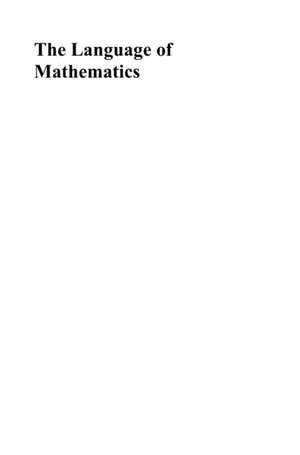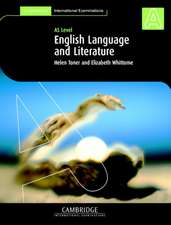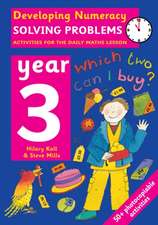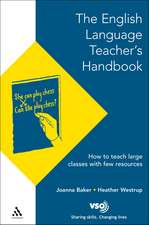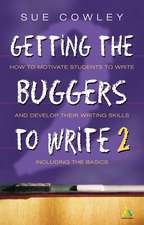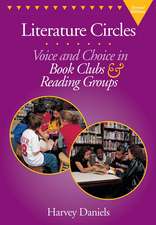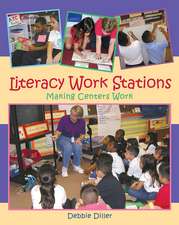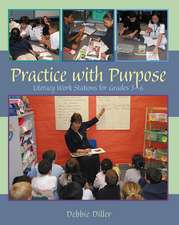The Language of Mathematics: Telling Mathematical Tales: Mathematics Education Library, cartea 44
Autor Bill Bartonen Limba Engleză Paperback – 23 feb 2009
| Toate formatele și edițiile | Preț | Express |
|---|---|---|
| Paperback (1) | 382.57 lei 6-8 săpt. | |
| Springer Us – 23 feb 2009 | 382.57 lei 6-8 săpt. | |
| Hardback (1) | 641.85 lei 6-8 săpt. | |
| Springer Us – 13 noi 2007 | 641.85 lei 6-8 săpt. |
Din seria Mathematics Education Library
-
 Preț: 389.70 lei
Preț: 389.70 lei - 15%
 Preț: 645.96 lei
Preț: 645.96 lei - 18%
 Preț: 742.97 lei
Preț: 742.97 lei - 18%
 Preț: 1394.84 lei
Preț: 1394.84 lei - 18%
 Preț: 947.50 lei
Preț: 947.50 lei - 18%
 Preț: 1544.80 lei
Preț: 1544.80 lei - 15%
 Preț: 652.49 lei
Preț: 652.49 lei - 18%
 Preț: 1385.67 lei
Preț: 1385.67 lei - 18%
 Preț: 1225.48 lei
Preț: 1225.48 lei - 15%
 Preț: 643.34 lei
Preț: 643.34 lei - 18%
 Preț: 1221.07 lei
Preț: 1221.07 lei - 18%
 Preț: 952.89 lei
Preț: 952.89 lei - 18%
 Preț: 950.52 lei
Preț: 950.52 lei - 24%
 Preț: 1445.40 lei
Preț: 1445.40 lei - 18%
 Preț: 1224.54 lei
Preț: 1224.54 lei - 15%
 Preț: 651.19 lei
Preț: 651.19 lei -
 Preț: 391.61 lei
Preț: 391.61 lei - 18%
 Preț: 948.16 lei
Preț: 948.16 lei - 18%
 Preț: 944.19 lei
Preț: 944.19 lei - 18%
 Preț: 1380.95 lei
Preț: 1380.95 lei - 18%
 Preț: 947.85 lei
Preț: 947.85 lei - 18%
 Preț: 948.61 lei
Preț: 948.61 lei - 15%
 Preț: 635.31 lei
Preț: 635.31 lei - 15%
 Preț: 644.63 lei
Preț: 644.63 lei - 15%
 Preț: 646.43 lei
Preț: 646.43 lei - 15%
 Preț: 647.59 lei
Preț: 647.59 lei
Preț: 382.57 lei
Nou
Puncte Express: 574
Preț estimativ în valută:
73.22€ • 75.86$ • 61.10£
73.22€ • 75.86$ • 61.10£
Carte tipărită la comandă
Livrare economică 21 martie-04 aprilie
Preluare comenzi: 021 569.72.76
Specificații
ISBN-13: 9780387929378
ISBN-10: 0387929371
Pagini: 186
Ilustrații: X, 186 p. 12 illus.
Dimensiuni: 155 x 235 x 11 mm
Greutate: 0.29 kg
Ediția:2008
Editura: Springer Us
Colecția Springer
Seria Mathematics Education Library
Locul publicării:New York, NY, United States
ISBN-10: 0387929371
Pagini: 186
Ilustrații: X, 186 p. 12 illus.
Dimensiuni: 155 x 235 x 11 mm
Greutate: 0.29 kg
Ediția:2008
Editura: Springer Us
Colecția Springer
Seria Mathematics Education Library
Locul publicării:New York, NY, United States
Public țintă
ResearchCuprins
Speaking Mathematics Differently.- Space: Points of Reference.- Space: Static and Dynamic World Views.- Quantity: Trapping Numbers in Grammatical Nets.- Language and Mathematics.- The Evidence from Language.- Mumbling, Metaphors, & Mindlocks: The Origins of Mathematics.- A Never-Ending Braid: the Development of Mathematics.- What is Mathematics? Philosophical Comments.- Implications for Mathematics Education.- Learning Mathematics.- Multilingual and Indigenous Mathematics Education.
Textul de pe ultima copertă
The Language of Mathematics: Telling Mathematical Tales emerges from several contemporary concerns in mathematics, language, and mathematics education, but takes a different stance with respect to language. Rather than investigating the way language or culture impacts mathematics and how it is learned, this book begins by examining different languages and how they express mathematical ideas. The picture of mathematics that emerges is of a subject that is much more contingent, relative, and subject to human experience than is usually accepted. Barton’s thesis takes the idea of mathematics as a human creation, and, using the evidence from language, comes to more radical conclusions than usual.
Everyday mathematical ideas are expressed quite differently in different languages. Variety occurs in the way languages express numbers, describe position, categorise patterns, as well as in the grammar of mathematical discourse. The first part of The Language of Mathematics: Telling Mathematical Tales explores these differences and thus illustrates the possibility of different mathematical worlds. This section both provides evidence of language difference with respect to mathematic talk and also demonstrates the congruence between mathematics as we know it and the English language. Other languages are not so congruent.
Part II discusses what this means for mathematics and argues for alternative answers to conventional questions about mathematics: where it comes from, how it develops, what it does and what it means. The notion that mathematics is the same for everyone, that it is an expression of universal human thought, is challenged. In addition, the relationship between language and mathematical thought is used to argue that the mathematical creativity embedded in minority languages should continue to be explored
The final section explores implications for mathematics education, discussing the consequences for the waysin which we learn and teach mathematics. The Language of Mathematics: Telling Mathematical Tales will appeal to those interested in exploring the nature of mathematics, mathematics educators, researchers and graduate students of mathematics education.
Everyday mathematical ideas are expressed quite differently in different languages. Variety occurs in the way languages express numbers, describe position, categorise patterns, as well as in the grammar of mathematical discourse. The first part of The Language of Mathematics: Telling Mathematical Tales explores these differences and thus illustrates the possibility of different mathematical worlds. This section both provides evidence of language difference with respect to mathematic talk and also demonstrates the congruence between mathematics as we know it and the English language. Other languages are not so congruent.
Part II discusses what this means for mathematics and argues for alternative answers to conventional questions about mathematics: where it comes from, how it develops, what it does and what it means. The notion that mathematics is the same for everyone, that it is an expression of universal human thought, is challenged. In addition, the relationship between language and mathematical thought is used to argue that the mathematical creativity embedded in minority languages should continue to be explored
The final section explores implications for mathematics education, discussing the consequences for the waysin which we learn and teach mathematics. The Language of Mathematics: Telling Mathematical Tales will appeal to those interested in exploring the nature of mathematics, mathematics educators, researchers and graduate students of mathematics education.
Caracteristici
Combines discussion of linguistics and mathematics using examples from each to illustrate the other Conclusions with respect to mathematics education provide alternatives to conventional practice Contains original material and ideas Based in experience and describes many examples that come from common experience Provides new insight into common mathematical experiences like fractions and circles
